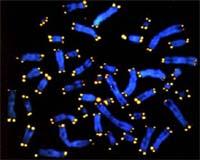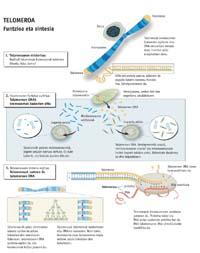Novel of Physiology or Medicine for those who found chromosome protectors
In fact, DNA is concentrated on chromosomes and the ends, the telomeres, have a special structure. Blackburn and Szostak discovered that a sequence of telomeres protected chromosomes from degradation. Greider and Blackburn identified telomerase, the enzyme produced by telomeres.
Telomeres and cell life

Telomeres are unique structures found at the end of chromosomes. (Photo: University of California)
As explained in the press release of the Nobel Academy, these discoveries are of vital importance, since the length of telomeres is related to the length of life of the cell: if telomeres are shortened, the cell dies; if on the contrary, the activity of telomerosis is intense, the death of the cells is delayed.
Therefore, the researchers consider that telomeres have a great importance in the aging of organisms and also in cancer. In fact, cancer cells are immortal and some researchers have seen that in these cells telomase has a great activity. What's more, treatments are currently being tested based on the destruction of telomerase to fight cancer.
In addition, some hereditary diseases are the result of telomerosis defects, such as congenital aplastic anemia. Thus, the discoveries of Blackburn, Greider and Szostak have allowed us to better understand the life of cells and the appearance of diseases. They have also opened the way to develop new therapies.
Discoveries, fruit of collaboration
The discoveries of the Nobel Prize winners are the result of collaboration. Precisely, in the early years of his career, when he was sequencing DNA, Blackburn discovered that at the end of the chromosomes of the unicellular organism Tetrahymena there was a sequence repeated several times.

(Picture: Nobel Foundation)
When he published the study, Szosta contacted Blackburn so that he could relate to the experiments he was carrying out with yeasts. Thus, together they conducted an experiment in which they saw that the telomere of Tetrahymena protected the chromosome from the yeast. Although both were very different, they concluded that they had the same mechanism at the base. The research, published in 1982, has shown that the sequence of telomeres is characteristic in most organisms, from amoebas to humans.
The discovery of Telomeras was the work of Greider and Blackburne. Blackburn was Greider's research director and believed that telomeres' DNA was produced by an enzyme. On Christmas Day 1984, Greider discovered that there was enzymatic activity in a cell extractive. Greider and Blackburn called the enzyme telomerase, purified it and clarified its function.
Buletina
Bidali zure helbide elektronikoa eta jaso asteroko buletina zure sarrera-ontzian











